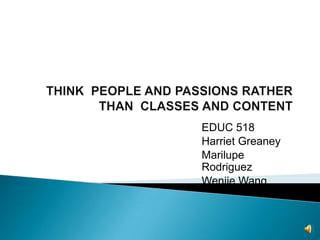
Chapter 3 to export
- 1. THINK PEOPLE AND PASSIONS RATHER THAN CLASSES AND CONTENT EDUC 518 Harriet Greaney Marilupe Rodriguez Wenjie Wang
- 2. A key aspect of “partnering” education is discovering students’ passions and interests. Today’s teachers need to help students discover, understand, and develop their passions. PARTNERING + PASSIONS
- 3. LEARN ABOUT STUDENTS’ INTERESTS AND PASSIONS While partnering, it is important to know students’ passions in detail. Passion provides a source of energy that inspires learners to make an effort and determines how long they will be willing to endure an activity, how hard they will pursue it, and how much they learn.
- 4. “Passion” means a person’s central focus, what the learner cares about most, or what moves him or her emotionally. A student need not become passionate about learning English in order to succeed in English class. Rather, the student needs connect English learning to his passionate interests. Today’s students expect individualized treatment. WHY LEARN ABOUT STUDENTS’ PASSIONS?
- 5. Educators must discover the passions of individual students—the things that truly interest them—and use them as the drivers of student engagement and achievement. By accessing students’ passions, we can create individual learning that will stick in students’ minds, be valuable in their lives, and make them want to know more. PASSIONS DRIVE STUDENT ENGAGEMENT
- 6. Educators can learn from their students by helping them find their passions and by organizing class activities around the theme of self-expression. To discover students’ passions, educators can use various methods--personalized tasks, idea journals, speaking circles, or interactive questionnaires. LEARN FROM YOUR STUDENTS
- 7. HOW CAN WE USE PASSIONS? To build respect and tolerance for individuality. To inspire more variety in our lessons. To allow us to create meaningful guiding questions. To encourage us to get and give constant feedback.
- 10. Researcher Technology expert Thinker World changer Self- teacher “Professional” STUDENTS’ ROLES
- 11. Encourage variations in team work and peer- to- peer learning. Address slacker-free group work. Hold class discussions. “Circle the Chairs” Use students as assistants. MORE IDEAS
- 12. The more educators think of students as individuals with their own passions, the more we use those passions to instruct and motivate, and the more we will reach all students. Students will be motivated to take advantage of opportunities and to display greater effort and concentration. Students will reveal positive emotions such as excitement, enthusiasm, interest, and optimism during learning. CONCLUSIONS
- 13. Prensky, M. (2010). Teaching digital natives: Partnering for real learning. Thousand Oaks, CA: Corwin a Sage Company. REFERENCE